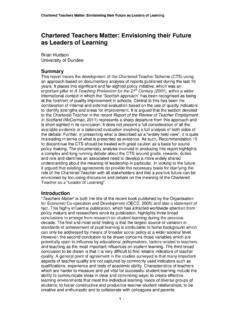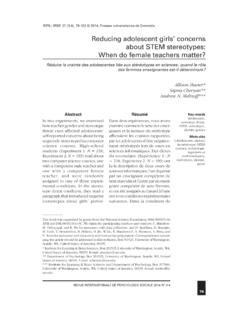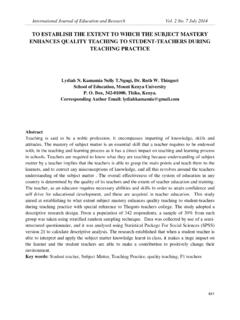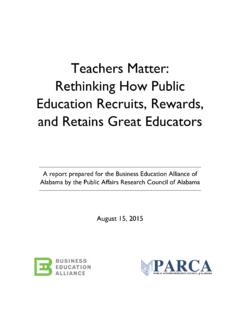Transcription of How context matters in high-need schools: The effects of ...
1 How context matters in high-need schools: The effects of teachers working conditions on their professional satisfaction and their students achievement Susan Moore Johnson Matthew A. Kraft John P. Papay Project on the Next Generation of Teachers Harvard Graduate School of Education June 29, 2011 We are indebted to the Ford Foundation for funding this research, to Eric Hirsch of the New teacher Center and Beverly Miyares of the Massachusetts Teachers Association for granting us access to the MassTeLLS data, and to our colleague, Ann Mantil, for her contribution to our analysis. Abstract Background/ context : Educational policymakers have begun to recognize the challenges posed by teacher turnover. Schools and students pay a price when new teachers leave the profession after only two or three years, just when they have acquired valuable teaching experience.
2 Persistent turnover also disrupts efforts to build a strong organizational culture and to sustain coordinated instructional programs throughout the school. Retaining effective teachers is a particular challenge for schools that serve high proportions of low-income and minority students. Although some interpret these turnover patterns as evidence of teachers discontent with their students, recent large-scale quantitative studies provide evidence that teachers choose to leave schools with poor work environments, and that these conditions are most common in schools that minority and low-income students typically attend (Boyd et al., 2011; Ladd, 2009 Borman & Dowling, 2008; Loeb, Darling-Hammond & Luczak, 2005). Thus, mounting evidence suggests that the seeming relationship between student demographics and teacher turnover is driven, not by teachers responses to their students, but by the conditions in which they must teach and their students are obliged to learn.
3 Purpose/Objective/Research Question/Focus of Study: We build on this body of work by further examining how working conditions predict both teachers job satisfaction and their career plans. We use a broad conception of the context of teachers work, paying attention not only to narrowly defined working conditions, but also to the interpersonal and organizational contexts in which teachers work. We also extend Ladd s (2009) analysis describing the relationship between the work context and student achievement. Advancing our understanding of this relationship is particularly important, given the increasing emphasis legislators place on evidence of student achievement when evaluating education policy. Specifically, we ask three research questions: (i) Do the conditions of work in Massachusetts public schools affect teachers satisfaction with their jobs and their career plans?
4 (ii) Are schools with better conditions of work more successful in raising student performance than schools with less supportive working conditions? (iii) If the conditions of work are important, what elements of the work environment matter the most? Research Design: In this paper, we combine a statewide survey of school working conditions (Mass TeLLS) with demographic and student achievement data from Massachusetts. We examine three primary outcomes: teacher satisfaction, teacher career intentions, and student achievement growth. From different items on the Mass TeLLS, we construct a set of nine key elements that reflect the broad-based conditions in which teachers work. We fit standard regression models that describe the relationship between each outcome and both overall conditions of work and each element separately, modeling this relationship according to the properties of our outcome variables.
5 Findings/Results: We find that measures of the school environment explain away much of the apparent relationship between teacher satisfaction and student demographic characteristics. The conditions in which teachers work matter a great deal to them and, ultimately, to their students. Teachers are more satisfied and plan to stay longer in schools that have a positive work context , independent of the school s student demographic characteristics. Furthermore, although a wide range of working conditions matter to teachers, the specific elements of the work environment that matter the most to teachers are not narrowly conceived working conditions such as clean and well-maintained facilities or access to modern instructional technology. Instead, it is the social conditions the school s culture, the principal s leadership, and relationships among colleagues that predominate in predicting teachers job satisfaction and career plans.
6 More importantly, providing a supportive context in which teachers can work appears to contribute to improved student achievement. We find that favorable conditions of work predict higher rates of student academic growth, even when we compare schools serving demographically similar groups of students. Conclusions/Recommendations: In short, we find that the conditions of teachers work matter a great deal. These results align with a growing body of work examining the organizational characteristics of the schools in which teachers work (Boyd et al., 2011; Ladd, 2011). Together, these studies suggest strongly that the high turnover rates of teachers in schools with substantial populations of low-income and minority students are driven largely by teachers fleeing the dysfunctional and unsupportive work environments in the schools to which low-income and minority students are most likely to be assigned.
7 If public education is to provide effective teachers for all students, then the schools those students attend must become places that support effective teaching and learning across all classrooms. Executive Summary Throughout the past decade of school reform from the No Child Left Behind Act of 2001 to the Race to the Top competition of 2010 policymakers focused attention on teachers, especially those in low-performing schools. Many state and district officials sought to recruit only the most promising teachers and to retain only the most effective ones, thereby building instructional capacity and eliminating the disparity in teachers effectiveness in schools serving students with the greatest need. However, district and school administrators quickly discovered that there was no guarantee that promising teachers would stay once they were hired.
8 In particularly, teachers steadily left schools in high-minority, high-poverty communities to work in schools in whiter, higher-income communities. Thus, the very schools that most needed effective teachers had the greatest difficulty attracting and retaining them. Schools and students pay a price when early-career teachers leave their high-need schools after two or three years, just when they have acquired valuable teaching experience. It becomes impossible for schools with ongoing turnover to build instructional capacity and to ensure that students in all classrooms have effective teachers. Also, persistent turnover in a school s teaching staff disrupts efforts to build a strong organizational culture, making it difficult to develop and sustain coordinated instructional programs throughout the school.
9 Researchers differ in how they explain the transfer and exit patterns that create hard-to-staff schools. Some who analyze large data sets interpret these turnover patterns as evidence of teachers discontent with their low-income or minority students; in other words, teachers are choosing to leave their students rather than their schools. An alternative explanation is that teachers who leave high-poverty, high-minority schools reject the dysfunctional contexts in which they work, rather than the students they teach. Using a 2008 working conditions survey given to all Massachusetts teachers, we construct measures of nine different elements of the school working environment. We estimate the relationship between our working conditions measures and several outcomes, including teachers satisfaction, their career intentions, and school-wide achievement growth reported by the state Department of Elementary and Secondary Education.
10 We confirm recent findings that teachers choose to leave schools with poor work environments, and that these conditions are most common in schools that minority and low-income students typically attend. In short, we find that the conditions of teachers work matter a great deal. Teachers who teach in favorable work environments report that they are more satisfied and less likely to plan to transfer or leave the profession than their peers in schools with less favorable conditions, even after controlling for student demographics and other school and teacher characteristics. In fact, differences in the work context account for much of the apparent relationship between student demographics and teacher turnover. These results align with a growing body of work examining the organizational characteristics of the schools in which teachers work.



















